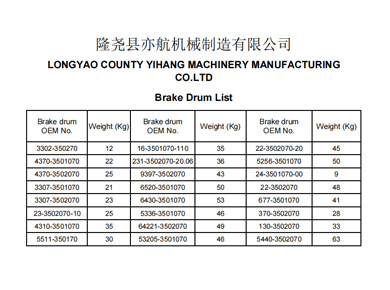2 月 . 15, 2025 10:16 Back to list
how to bleed brake drums
Bleeding brake drums is a crucial aspect of vehicle maintenance, ensuring the braking system functions effectively and reliably. This process eliminates trapped air from the brake lines, maintaining hydraulic pressure within the system. It's an essential procedure that car enthusiasts and maintenance professionals must understand. Here's a comprehensive guide on how to bleed brake drums efficiently and safely, ensuring an optimal braking system.
Have an assistant press down on the brake pedal slowly and steadily. As the pedal is pressed, open the bleeder screw using a correct-sized wrench, allowing fluid and air to escape into the catch bottle. Your assistant should maintain pressure on the pedal until you close the bleeder screw. This cycle should be repeated until the fluid runs clear without any air bubbles, indicating that the air has been successfully purged from the line. Repeat this procedure for each brake drum, progressing from the farthest to the nearest in relation to the master cylinder. This systematic approach ensures a thorough bleeding of the system, promoting an even distribution of fluid and pressure throughout. The order typically follows passenger side rear, driver side rear, passenger side front, and driver side front. Throughout the bleeding process, regularly check the brake fluid level in the reservoir. It should remain above the minimum mark to prevent air from re-entering the system. Consistently maintaining the fluid level exemplifies a meticulous attention to detail, underscoring the importance of following manufacturer guidelines for brake fluid type and specifications. After bleeding all brake drums, take a moment to inspect the entire brake system for leaks. Check each bleeder screw and ensure they're tight, but be cautious not to overtighten, which can strip threads or break the screw. An inspection reinforces a proactive approach to vehicle maintenance, ensuring long-term reliability and safety. Finally, test the brake pedal for firmness before driving the vehicle. The pedal should feel firm and responsive. A spongy pedal could indicate remaining air in the system or a potential brake line issue that necessitates further inspection or professional intervention. Testing after maintenance is an essential practice, guaranteeing that the vehicle is roadworthy. This comprehensive guide to bleeding brake drums focuses on safety, precision, and professionalism. By following these steps, you enhance your vehicle's braking performance, extend the lifespan of your brake components, and ensure a safe driving experience. Adopting an expert approach to vehicle maintenance not only improves performance but also engenders trust and reliability in your automotive endeavors.


Have an assistant press down on the brake pedal slowly and steadily. As the pedal is pressed, open the bleeder screw using a correct-sized wrench, allowing fluid and air to escape into the catch bottle. Your assistant should maintain pressure on the pedal until you close the bleeder screw. This cycle should be repeated until the fluid runs clear without any air bubbles, indicating that the air has been successfully purged from the line. Repeat this procedure for each brake drum, progressing from the farthest to the nearest in relation to the master cylinder. This systematic approach ensures a thorough bleeding of the system, promoting an even distribution of fluid and pressure throughout. The order typically follows passenger side rear, driver side rear, passenger side front, and driver side front. Throughout the bleeding process, regularly check the brake fluid level in the reservoir. It should remain above the minimum mark to prevent air from re-entering the system. Consistently maintaining the fluid level exemplifies a meticulous attention to detail, underscoring the importance of following manufacturer guidelines for brake fluid type and specifications. After bleeding all brake drums, take a moment to inspect the entire brake system for leaks. Check each bleeder screw and ensure they're tight, but be cautious not to overtighten, which can strip threads or break the screw. An inspection reinforces a proactive approach to vehicle maintenance, ensuring long-term reliability and safety. Finally, test the brake pedal for firmness before driving the vehicle. The pedal should feel firm and responsive. A spongy pedal could indicate remaining air in the system or a potential brake line issue that necessitates further inspection or professional intervention. Testing after maintenance is an essential practice, guaranteeing that the vehicle is roadworthy. This comprehensive guide to bleeding brake drums focuses on safety, precision, and professionalism. By following these steps, you enhance your vehicle's braking performance, extend the lifespan of your brake components, and ensure a safe driving experience. Adopting an expert approach to vehicle maintenance not only improves performance but also engenders trust and reliability in your automotive endeavors.
Latest news
-
Brake Drum for Kamaz Trucks Durable OEM Replacement & High Performance
NewsMay.30,2025
-
Brake Drum Man High-Quality Drum Brake & Shoe Solutions
NewsMay.30,2025
-
High-Performance Brake Drum for Kamaz Trucks Durable Drum Brake Components
NewsMay.29,2025
-
Brake Drum Man High-Quality Drum Brake Drums & Brake Shoes
NewsMay.29,2025
-
Brake Drum MAZ High-Performance & Durable Replacement Parts
NewsMay.29,2025
-
heavy truck brake drums
NewsMar.07,2025
